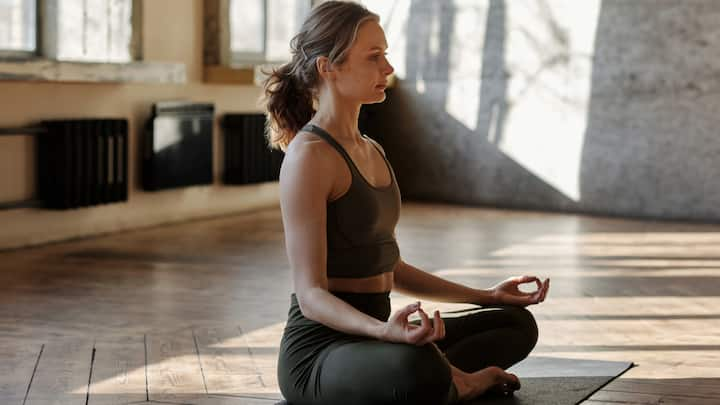
1. By Triggering the Relaxation Response: Throughout the day, our body & mind are in a ‘fight or flight’ mode, which is essential to handle the day’s challenges and stresses effectively with the help of our sympathetic nervous system. But in many people, even after the work day ends, the sympathetic nervous system remains overly activated, which is one of the key hindrances to a sleepful night. To neutralize this and to induce calm and sleep, you need to do yoga poses that activate the parasympathetic nervous system, which is responsible for the ‘rest and digest’ mode, by triggering the Relaxation Response. Supta Baddha Konasana (Reclining Bound Angle Pose) is renowned for the activation of the parasympathetic nervous system, thereby helping the body, mind & brain to relax and slip into deep sleep fast. (Image source: Canva)

2. By Regulating the Circadian Rhythm: A high percentage of those suffering from poor sleep or insomnia, have developed this issue due to years of violating and neglecting their body’s internal clock or circadian rhythm. For instance, many people routinely sleep past midnight, even past 1 AM, and always get up past sunrise, at 7 AM or even beyond. A very recent study done on massive UK Biobank data found that regularly sleeping past midnight is a perfect recipe for developing mental diseases like depression, anxiety etc, which are often precursors to sleeplessness or insomnia. Yoga has some powerful tools to correct this and it involves doing some specific asanas at specific times. Since the circadian rhythm is guided by the waxing and waning of natural light, that is from the sun, a preferred technique is to do yoga’s renowned Suryanamaskar sequence of asanas at both sunrise and sunset. (Image source: Canva)

3. By Breath Awareness Nothing helps the relaxation of mind & body, as much as being aware of one’s own breath. This in turn induces sleep like nothing else can. While deep breathing, box breathing, slow breathing and various yogic pranayamas are all beneficial, these breathing methods are typically done in short sessions, and hence need to be complemented with an always-on kind of breath awareness. Most people are never aware of their breath throughout the day, as they are either talking frequently or using their mouth too to breathe. Correcting this is simple, as it involves just closing your mouth, and being aware of the air that is rushing in through your nostrils and soon enough coming back. You are able to feel this now as nasal breathing has more resistance. This resistance is also beneficial in relaxing our blood vessels and reducing BP as it helps in generating nitric oxide, a key relaxing molecule. (Image source: Canva)

4. By Achieving Comfort Many people find it difficult to sleep soundly due to various common pains like back pain, neck pain, knee pain etc. Sleep disrupting pains can also be psychological like anxiety, tension & depression. Some yoga poses are renowned to alleviate such physical and mental pains in one go, so that your body and mind achieve the comfort it needs to slip into sleep and remain asleep till dawn. These yoga poses work by gently stretching your body and regulating your breath from fast shallow breaths to slow deep breaths, thereby bringing a state of bliss or joy (ananda). Yoga asanas that can induce sleep this way include Balasana (Child’s Pose), Viparita Karani (Legs-Up-The-Wall Pose), Ananda Balasana (Happy Baby Pose) and Savasana (Corpse Pose). (Image source: Canva)

5. By Personalized Yoga There will be many people who can’t sleep perfectly despite following yogic and other methods for relaxation and sound sleep. The reason for this can be two-fold. One, their genetic predisposition to anxiety, depression, insomnia etc, and the other, their poorly managed diabetes, obesity & other lifestyle diseases. While insomnia’s link with poor sugar control is infamous, being obese can contribute to sleep apnea, a leading cause of sleeplessness. Today, a genetic test and a metabolic assessment can find out such roots of insomnia, so that remedial actions by way of personalized lifestyle modifications can be undertaken. (Image source: Canva)

Inputs By: Sajeev Nair, Founder and Chairman, Vieroots Wellness Solutions (Image source: Canva)
Published at : 19 Jun 2024 11:28 AM (IST)






